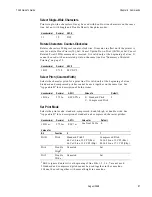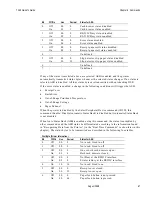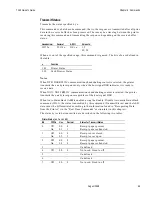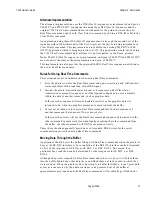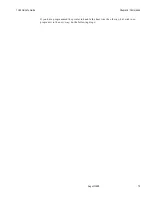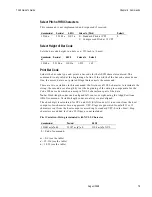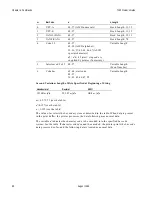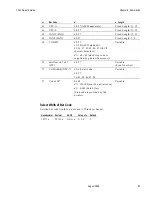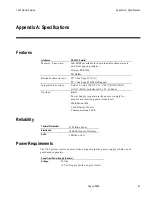
Chapter 6: Commands
7193 Owner’s Guide
August 1998
70
Cash Drawer Status (n = 2 or n = 50)
Bit
Off/On
Hex
Decimal
Status for Transmit Status
0
Off
On
00
01
0
1
One or both cash drawers open.
Both cash drawers closed.
1
Off
On
00
02
0
2
One or both cash drawers open.
Both cash drawers closed.
2
-
-
-
Undefined
3
-
-
-
Undefined
4
Off
00
0
Not used. Fixed to off.
5
-
-
-
Undefined
6
-
-
-
Undefined
7
Off
00
0
Not used. Fixed to off.
Real Time Commands
The Real Time commands provide an application interface to the printer even when the
printer is not handling other commands (RS-232C communication interface only):
•
Real Time Status Transmission: GS (Hex 1D) Sequence and DLE (Hex 10) Sequence
•
Real Time Request to Printer: GS (Hex 1D) Sequence and DLE (Hex 10) Sequence
•
Real Time Printer Status Transmission
The original Printer Status commands, Transmit Printer Status (Hex 1B 76, ASCII ESC v)
and Transmit Cash Drawer Status (Hex 1B 75 0, ASCII ESC u 0) are placed in the
printer’s data buffer as they are received and handled by the firmware in the order in
which they were received. If the paper exhausts while printing data which was in the
buffer ahead of the status command, the printer goes busy at the RS-232C interface and
suspends processing the data in the buffer until paper is reloaded. This is true for all error
conditions: knife home error, thermal printhead overheat, etc. In addition, there is no way
to restart the printer after a paper jam or other error.
The Real Time commands are implemented in two ways to correct these problems. Both
implementations offer the same functionality; which one you choose depends on the
current usage of your application.
First Implementation
For a new application the GS (Hex 1D) sequences of the first implementation are
recommended to avoid possible misinterpretation of a DLE (Hex 10) sequence as a Clear
Printer (Hex 10 0, ASCII DLE NUL)
command.
The first implementation builds upon the GS ENQ sequence as implemented on Epson’s
TM-930II™, TM-950™ and TM-U950™ by defining two new GS (Hex 1D) sequences to
provide the same functions as the DLE (Hex 10) sequences above, and to provide complete
backward compatibility to the original 7193 Clear Printer command.
An application using these GS (Hex 1D) sequences does not need to distinguish for the
printer between the new Real Time commands and the old Clear Printer command. This
implementation is ideal for an existing 7193 application which already uses the Clear
Printer command or for a new application being developed.
This implementation also provides the original GS ENQ Real Time sequence in addition to
the newer Real Time sequences.
Summary of Contents for 7193
Page 1: ...BD20 1439 A Issue B August 1998 NCR 7193 Thermal Receipt Printer Owner s Guide ...
Page 6: ...Contents 7193 Owner s Guide August 1998 x ...
Page 16: ...Chapter 2 Setting Up the Printer 7193 Owner s Guide August 1998 10 Parallel Models ...
Page 22: ...Chapter 2 Setting Up the Printer 7193 Owner s Guide August 1998 16 ...
Page 24: ...Chapter 2 Setting Up the Printer 7193 Owner s Guide August 1998 18 ...
Page 26: ...Chapter 2 Setting Up the Printer 7193 Owner s Guide August 1998 20 ...
Page 30: ...Chapter 3 Solving Problems 7193 Owner s Guide August 1998 24 ...
Page 48: ...Chapter 5 Communication 7193 Owner s Guide August 1998 42 ...
Page 88: ...Chapter 6 Commands 7193 Owner s Guide August 1998 82 ...
Page 96: ...Appendix B Print Characteristics 7193 Owner s Guide August 1998 88 ...
Page 102: ...Index 7193 Owner s Guide August 1998 94 ...
Page 103: ......


